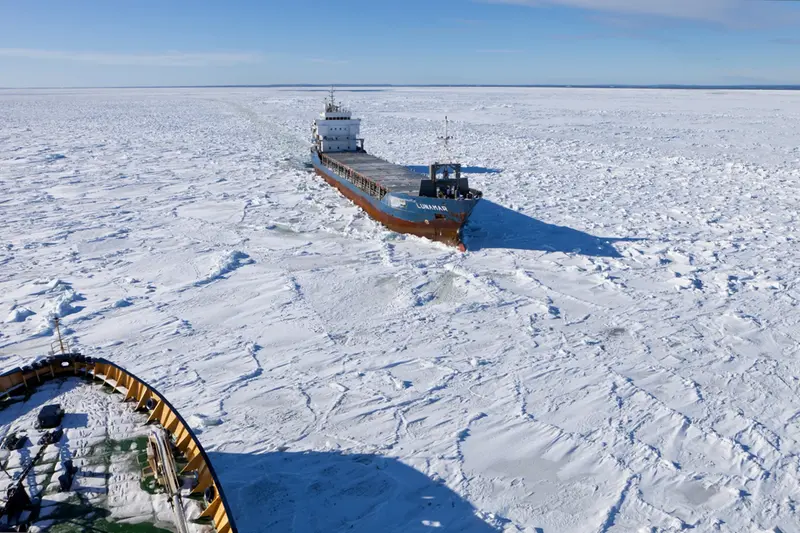Oceanographic research and development
At the Oceanographic research group, research is based on oceanography, the study of the sea, and links the physics of the sea with biological, geological and chemical processes in the ocean. We are about 20 specialists in fields ranging from oceanography and marine biology to mathematics and computer programming. We increase society's knowledge of the state of the sea to facilitate sustainable management of our ocean.

”The ocean is important for everyone”
About the researchFind on this page
Much of SMHI's oceanographic research focuses on our surrounding sea areas; the Baltic Sea, Kattegat and Skagerrak, but we also conduct research for the North Sea and Arctic Ocean.
We are specialists in a number of areas related to marine research, such as marine biology, marine observations, numerical modeling and remote sensing.
We work with marine observational data, oceanographic analysis and the development of computational models and methods. The models are used to make forecasts, study processes and predict future ocean climate.
Our research results are used in products that benefit a wide range of fields, such as oil spill response, shipping, sea rescue, and warnings of algal blooms and high or low water levels.
The results are also used to plan actions needed to meet national environmental quality objectives and to support decision-making on water management, adaptation to future climate and mitigation of climate impacts.
Our oceanographic research focuses on three main research areas: Ocean Climate, Marine Environment and Operational Oceanographic Research and Model Development.

Ocean Climate
The role of the ocean in the climate system

Marine Environment
The sea as a habitat

Operational Oceanographic Research and Model Development.
Sea forecasts and warnings
SMHI's oceanographic research unit participates in many national and international projects. We develop ocean modeling and ocean observations and link them with central services and with various issues, both around historical reconstructions and climate change in the Baltic Sea, the North Sea and the Arctic.
CS-MACH1 - Marine Citizen Science data Horizon
CS-MACH1 aims at developing a Marine Citizen Science (MSC) data network and associated online hub to support MCS initiatives in the acquisition and integration of data by users.CodeBlue – sustainable eutrophication management of the North-East Atlantic Ocean and Baltic Sea
Harmonised ocean data sets for blue sustainable eutrophication management of the North-East Atlantic Ocean and Baltic Sea.
Numerical models are the main tools in oceanographic research. At SMHI, several advanced models are developed and used to describe the physical and biogeochemical processes in the ocean. Sometimes the models can also be linked together into a multi-model system.
The various model systems are used to make forecasts and enable SMHI to issue warnings and study environmental changes in the marine ecosystem and the effects of climate change.
The main modeling systems today are EC-Earth, NEMO, PADM, SCOBI and SCM.
%20FoU-Oce_Internat%20Gbg%20v%C3%A5ren%202024.webp)
All of us at the oceanographic research unit
The unit is led by Sam Fredriksson, Elin Almroth-Rosell and Lars Axén.
We publish our research results in international peer-reviewed journals and in SMHI reports. The two most recent publications from SMHI's oceanographic research are:
Oceanografisk klimatpåverkan på undervattensverksamhet i Östersjön och Västerhavet
Dorothée Vallot, Magnus Hieronymus, Lars Axell
In: Oceanografi
2025
Abstract
In this report, we examine how the oceanographic climate of the Baltic Sea and the Skagerrak–Kattegat region is expected to change and impact the sound speed in the future for two time periods, 2040–2050 and 2090–2099, compared with 2015–2024. The speed of sound in se-awater is primarily determined by three physical variables: temperature, salinity, and pressure. Because these parameters vary between marine environments, sound speed is not homogene-ous in the ocean. Changes in these variables with depth create complex vertical profles that infuence how sound propagates. To model temperature and salinity, we use NEMO-Nordic, a high-resolution ocean model for the Baltic Sea, the North Sea, and the English Channel, based on the internationally developed NEMO system. The model is forced with atmospheric data from three climate models (EC-Earth, HadGEM, and MPI) under three CMIP5 scenarios (RCP2.6, RCP4.5, and RCP8.5), resulting in three model members for each scenario. The sound-speed profles show clear seasonal inversions, with temperature — and thus sound speed — being lowest at the surface in winter and highest in summer. In all scenarios, sound speed increases over time, while salinity decreases, especially under RCP8.5, mainly due to an intensifed hydrological cycle. However, future salinity levels in the Baltic Sea are highly uncertain. The trends are similar in the Skagerrak–Kattegat region and the Baltic Sea, but the changes appear earlier in the Baltic Sea (from around 2040) and intensify toward the end of the century, particularly in RCP8.5.
An extensive cyanobacteria bloom in the Baltic Sea area 2025
Bengt Karlson, Lars Arneborg, Lars Axell, Mikael Hedblom, Maria Karlberg, Anders Torstensson
SMHI leads unique international research project to counteract eutrophication
Eutrophication remains a serious problem for the Baltic Sea and the north-eastern Atlantic. This affects many marine sectors, such as fishing, tourism and aquaculture. SMHI's oceanographic researchers are leading a major European project which will increase the knowledge needed for sustainable marine management, partic...
SMHI recruits Professor of Oceanography
To further strengthen and profile SMHI's expertise in oceanographic research, the position of Professor of Oceanography is now advertised. With a focus on climate effects and other anthropogenic impacts on the ocean, operational oceanography and data assimilation or biogeochemical and physical processes and their impac...SMHI's research at EGU 2023
SMHI will participate in the annual research conference European Geosciences Union General Assembly in Vienna. This year SMHI's researchers will participate in various events within our disciplines of meteorology, hydrology, oceanography and climate.

